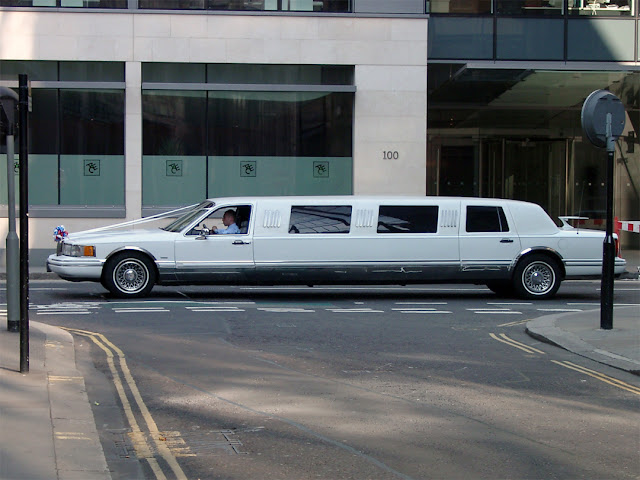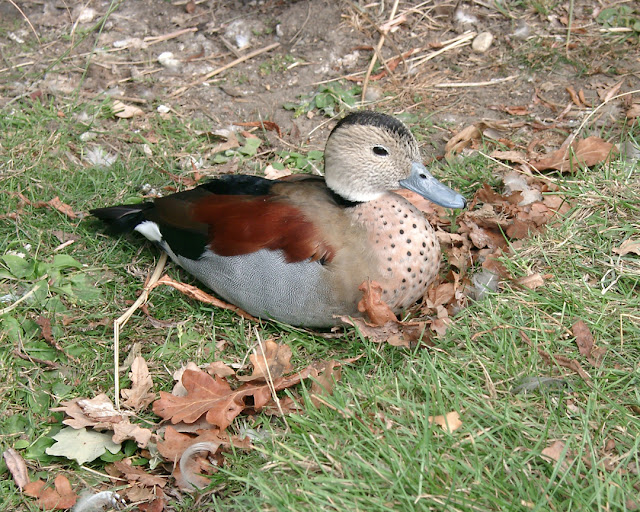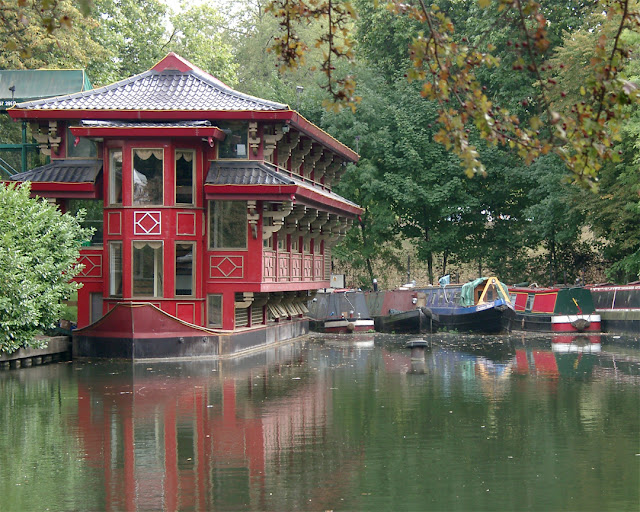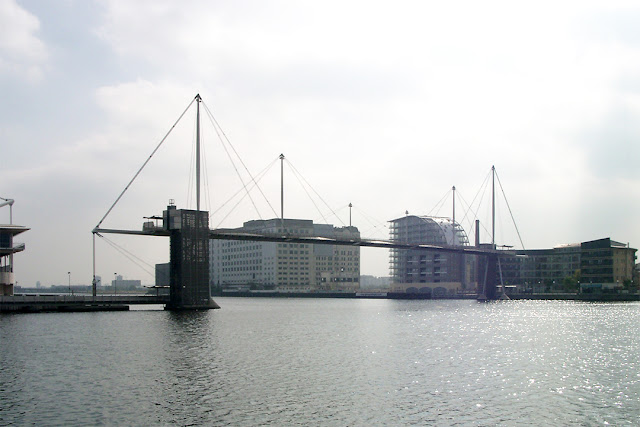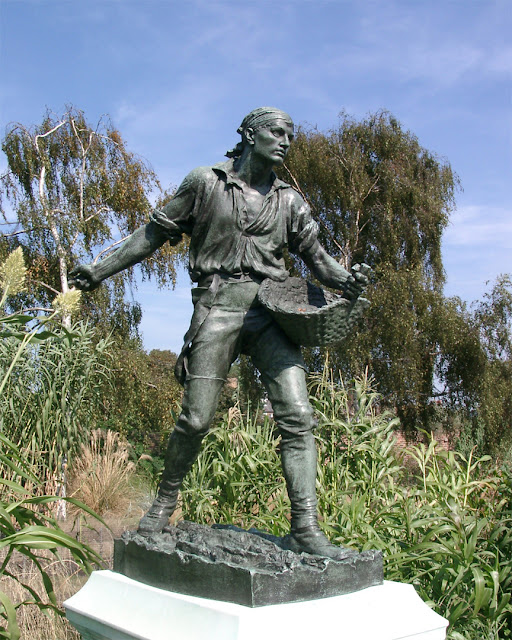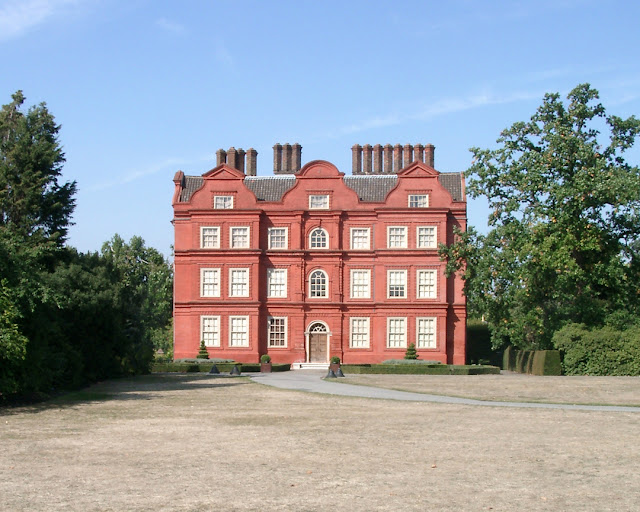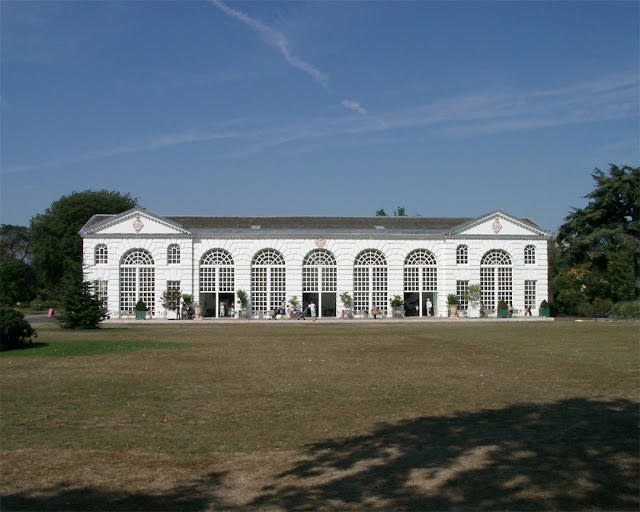Tuesday, November 30, 2004
The World Has Been Empty
“The World Has Been Empty Since the Romans” by Ian Hamilton Finlay, 1985
Tate Modern
Bankside, Southwark
London, September 2003
“The World Has Been Empty Since the Romans 1985 is a long and extremely heavy stone sculpture that resembles the ruin of a classical frieze and hangs from a series of steel chains. The text of its title – ‘THE WORLD HAS BEEN EMPTY SINCE THE ROMANS’ – is inscribed across its front in a traditional-looking serif typeface. The sculpture is made from six pieces of Bath stone, which is a form of limestone, and the faces of the stones are quite smooth, but are marked by what look like signs of weathering. They have jagged tops, bottoms and sides and the inscribed text is often broken up by joins between the different slabs, as well as what look like missing sections of stone. There is no fixed height from which the work must be hung, so that in some exhibitions it has been presented well above head height and in others it has been suspended only a short distance from the ground. However, all of the stones are hung at the same level as each other every time it is installed.” (The World Has Been Empty Since the Romans, Tate)
Monday, November 29, 2004
LSE Library ramp
Spiral stepped ramp
British Library of Political and Economic Science
Portugal Street, Holborn
London, September 2003
“The library underwent a £35 million building redevelopment in 2000, overseen by Foster and Partners. The building was officially reopened on 27 November 2001 by The Princess Royal and was commended in the 2002 Civic Trust Awards - given to outstanding examples of architecture and environmental design in major city areas of the UK, taking into account the benefit each project brings to its local area as well as the quality of its design. A further redevelopment in summer 2007, saw the expansion of the Course Collection by 60%, a new help desk, more study spaces and an increase in self-service facilities. The Lionel Robbins Building covers 20,000 square metres, and offers 1,700 study places, including 450 networked PCs and 226 laptop drop-in points. A light-filled atrium, named after Michael Peacock and spiral stepped ramp culminate at the top in a partially glazed dome which has been precisely angled to maximise daylight with minimal solar glare. A reflecting panel on the roof also helps to direct sunlight to the floors below. The dome and other windows respond automatically according to the temperature in the building; ventilating it naturally.” (British Library of Political and Economic Science, Wikipedia)
Sunday, November 28, 2004
LSE Library Atrium
Atrium
British Library of Political and Economic Science
Portugal Street, Holborn
London, September 2003
“The library underwent a £35 million building redevelopment in 2000, overseen by Foster and Partners. The building was officially reopened on 27 November 2001 by The Princess Royal and was commended in the 2002 Civic Trust Awards - given to outstanding examples of architecture and environmental design in major city areas of the UK, taking into account the benefit each project brings to its local area as well as the quality of its design. A further redevelopment in summer 2007, saw the expansion of the Course Collection by 60%, a new help desk, more study spaces and an increase in self-service facilities. The Lionel Robbins Building covers 20,000 square metres, and offers 1,700 study places, including 450 networked PCs and 226 laptop drop-in points. A light-filled atrium, named after Michael Peacock and spiral stepped ramp culminate at the top in a partially glazed dome which has been precisely angled to maximise daylight with minimal solar glare. A reflecting panel on the roof also helps to direct sunlight to the floors below. The dome and other windows respond automatically according to the temperature in the building; ventilating it naturally.” (British Library of Political and Economic Science, Wikipedia)
Saturday, November 27, 2004
Friday, November 26, 2004
Helical walkway
Helical walkway
City Hall by Foster and Partners, 2002
The Queen's Walk, Southwark
London, September 2003
Thursday, November 25, 2004
Wednesday, November 24, 2004
Blaine's crane
David Blaine's “Above the Below”
Potters Fields Park
Southwark
London, September 2003
“On September 5, 2003, Blaine began an endurance stunt in which he was sealed inside a transparent Plexiglas case. The case was suspended 30 feet (9.1 metres) in the air next to Potters Fields Park on the south bank of the River Thames in London, and measured 3 feet (0.9 metres) by 7 feet (2.1 metres) by 7 feet (2.1 metres). A webcam was installed inside the case so that viewers could observe his progress. The stunt lasted 44 days, during which Blaine drank 1.2 US gallons (4.5 litres) of water per day and did not eat. The stunt was the subject of public interest and media attention, The Times reported that ‘1,614 articles in the British press have made reference to the exploit.’” (David Blaine, Wikipedia)
Tuesday, November 23, 2004
Chelsea Bridge
Chelsea Bridge
Chelsea / Battersea
London, September 2003
“Chelsea Bridge is a bridge over the River Thames in west London, connecting Chelsea on the north bank to Battersea on the south bank, and split between the City of Westminster, the London Borough of Wandsworth and the Royal Borough of Kensington and Chelsea. There have been two Chelsea Bridges, on the site of what was an ancient ford.” (Chelsea Bridge, Wikipedia)
Monday, November 22, 2004
The Japanese Eagle
The Japanese Eagle
Queen Mary’s Gardens
Regent's Park
London, September 2003
“This statue, in the middle of the lake in Queen Mary’s Gardens, was given to the Park in 1974 by Felix Greene in memory of his father, Edward Greene, who had been a very successful coffee merchant, spending 20 years in Brazil before returning to London 1910, and later becoming chairman of the Brazilian Warrant Company. The eagle had been in the garden of Edward Greene’s lovely farmhouse at Little Wittenham, near Oxford, during the 1930s. It was recently restored to its former glory.” (The Japanese Eagle, The Royal Parks)
Sunday, November 21, 2004
Saturday, November 20, 2004
Friday, November 19, 2004
Ready Money Drinking Fountain
Ready Money Drinking Fountain
Broad Walk
Regent's Park
London, September 2003
“The Ready Money Drinking Fountain is a four-sided granite and marble gothic drinking fountain that gets its unusual name from Sir Cowasjee Jehangir, whose nickname was Ready Money. It is located in the centre of the Broad Walk. Ready Money was a wealthy Parsee industrialist from Bombay who donated it to The Regent's Park in 1869 as a thank-you for the protection that he and fellow Parsees received from British rule in India. The sculpture contains 10 tonnes of Sicilian marble and four tonnes of red Aberdeen granite. It was unveiled by Princess Mary of Teck, later Queen Mary after whom Queen Mary's Gardens are named.” (Ready Money Drinking Fountain, The Royal Parks)
Thursday, November 18, 2004
Wednesday, November 17, 2004
Tuesday, November 16, 2004
Cumberland Basin
Feng Shang Princess floating restaurant
Prince Albert Road
Cumberland Basin, Regent's Canal
London, September 2003
Monday, November 15, 2004
Doric Villa
Doric Villa by Quinlan Terry
Seen from the Regent's Canal
Outer Circle, Regent's Park
London, September 2003
Sunday, November 14, 2004
Ionic Villa
Ionic Villa by Quinlan Terry
Seen from the Regent's Canal
Outer Circle, Regent's Park
London, September 2003
Saturday, November 13, 2004
Veneto Villa
Veneto Villa by Quinlan Terry
Seen from the Regent's Canal
Outer Circle, Regent's Park
London, September 2003
Friday, November 12, 2004
Thursday, November 11, 2004
Wednesday, November 10, 2004
Westbourne Terrace Road bridge
Westbourne Terrace Road bridge
Westbourne Terrace Road
Little Venice, City of Westminster
London, September 2003
Tuesday, November 9, 2004
Butterfly Bridge
Rotherhithe Tunnel Footbridge by Nicholas Lacey and Partners, 1998
St James Gardens, Rotherhithe
London, September 2003
“This footbridge spans across the northern approach road to Rotherhithe Tunnel in east London, providing a direct route from St James Gardens at its north end to various streets and housing at its south end. The south end spills onto a piazza behind the horrible post-modern ventilation building which sits over the west portal of another tunnel, the Limehouse Link, completed in 1993. The bridge connection is useful but not vital. There’s an alternative route a short distance to the east, but that involves crossing the Rotherhith Tunnel roadway at grade, so the bridge is a welcome alternative. The footbridge was built for £550,000 in 1998, to a design by Nicholas Lacey and Partners with Whitby Bird and Engineers and WS Atkins. It was reportedly nicknamed the "butterfly bridge" at the time. Obviously something was in the air as a similar twin inclined arch bridge also nicknamed the ‘butterfly bridge’ was built in Bedford the year before, with a different design team. Whitby Bird and Lacey also collaborated on the St Saviour's Dock swing bridge around the same time, and there are definitely some similarities.” (Rotherhithe Tunnel Footbridge, The Happy Pontist)
Monday, November 8, 2004
Sunday, November 7, 2004
The Dock and Canary Wharf
Royal Victoria Dock and Canary Wharf
Seen from the Royal Victoria Dock Bridge
London, September 2003
Saturday, November 6, 2004
Royal Victoria Dock Bridge
Royal Victoria Dock Bridge
Royal Victoria Dock
London, September 2003
“The Royal Victoria Dock Bridge is a signature high-level footbridge crossing the Royal Victoria Dock in the Docklands area of east London designed by London-based architects and designers Lifschutz Davidson Sandilands. The bridge provides a direct link from Eastern Quay and Britannia Village, a residential development to the south of the dock, to the ExCeL Exhibition Centre and Custom House station, both situated to the north of the dock. The bridge takes the form of an inverted Fink truss, with six masts rising above the deck at 25.5 m (84 ft) centres, varying in height from almost 30 m (100 ft) at each end to just 10.6 m (35 ft) for the smallest masts. The shape of the bridge is designed to reflect the masts of the sailing boats which use the dock. The bridge crosses the dock with a clearance of some 15 m (50 ft) above the water, a height which was necessary to allow yachts to pass below the bridge deck. The bridge is accessed at each end by lift and stair towers. The bridge was completed in 1998, at a cost of £5 million. A second construction stage envisaged in the bridge's design involves the addition of a glass passenger cabin travelling on a rail of the underside of the deck to make this a transporter bridge.[2]” (Royal Victoria Dock Bridge, Wikipedia)
Friday, November 5, 2004
Thursday, November 4, 2004
Kew Palace
Kew Palace
Royal Botanic Gardens
Kew, Richmond
London, September 2003
“Kew Palace is a British royal palace within the grounds of Kew Gardens on the banks of the River Thames. Originally a large complex, few elements of it survive. Dating to 1631 but built atop the undercroft of an earlier building, the main survivor is known as the Dutch House. Its royal occupation lasted from around 1728 until 1818, with a final short-lived occupation in 1844. The Dutch House is Grade I listed, and open to visitors. It is cared for by an independent charity, Historic Royal Palaces, which receives no funding from the government or the Crown. Alongside the Dutch House is a part of its 18th-century service wing, whilst nearby are a former housekeeper's cottage, brewhouse and kitchen block – most of these buildings are private, though the kitchens are open to the public. These kitchens and Queen Charlotte's Cottage are also run by Historic Royal Palaces.” (Kew Palace, Wikipedia)
Wednesday, November 3, 2004
Tuesday, November 2, 2004
Stag beetle loggery
Stag beetle loggery
Royal Botanic Gardens
Kew, Richmond
London, September 2003
“The remarkable stag beetle loggery at Kew Gardens. This giant beetle model is an educational exhibit with the added aim of providing a home for saproxylic insects (those which feed on decaying wood), and in particular to provide a safe haven for stag beetles which are globally endangered. It is found in the conservation area of Kew Gardens around Queen Charlotte’s cottage, kept wild. London is a stronghold for stag beetles.” (Stag beetle loggery at Kew Gardens, Wild Britain Map)
Monday, November 1, 2004
Subscribe to:
Posts (Atom)




